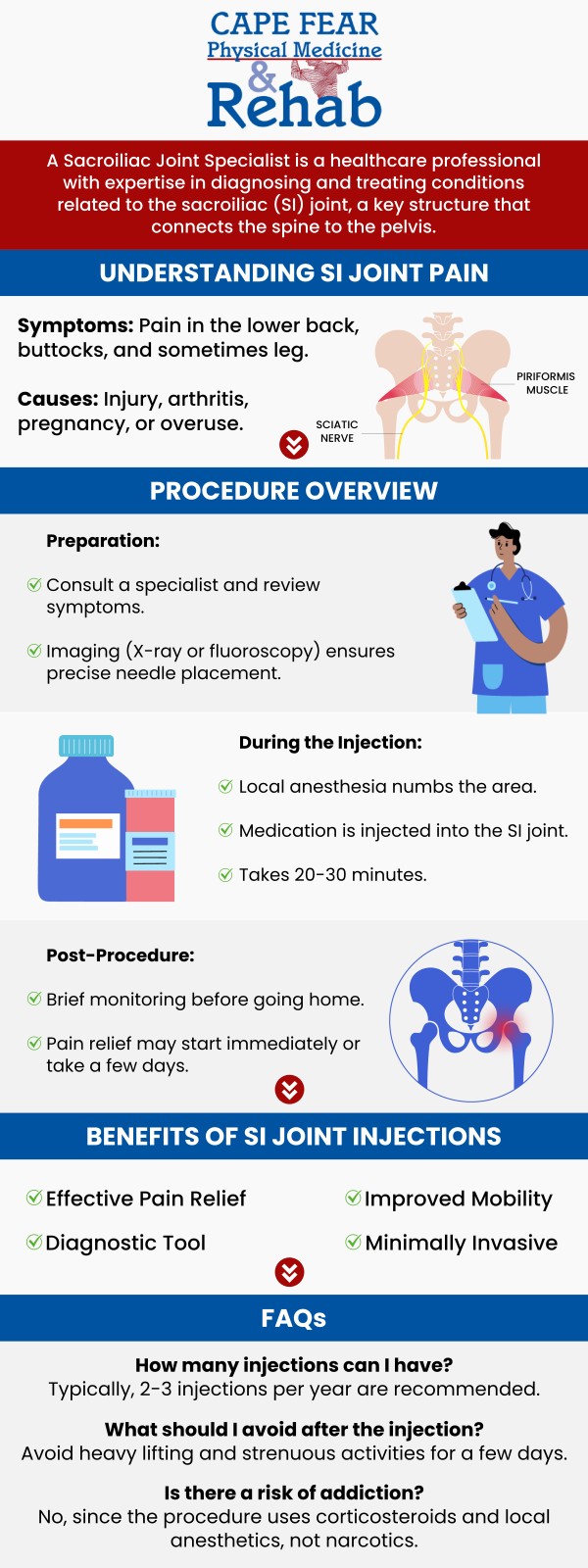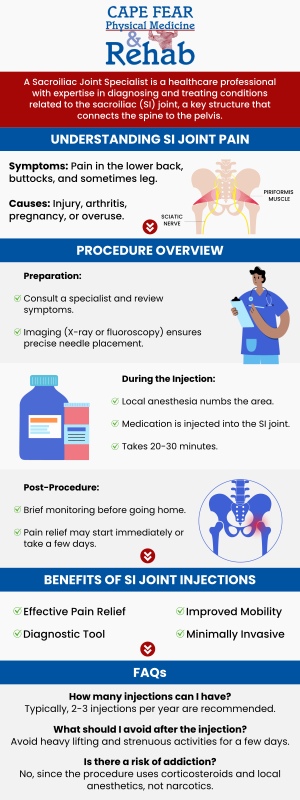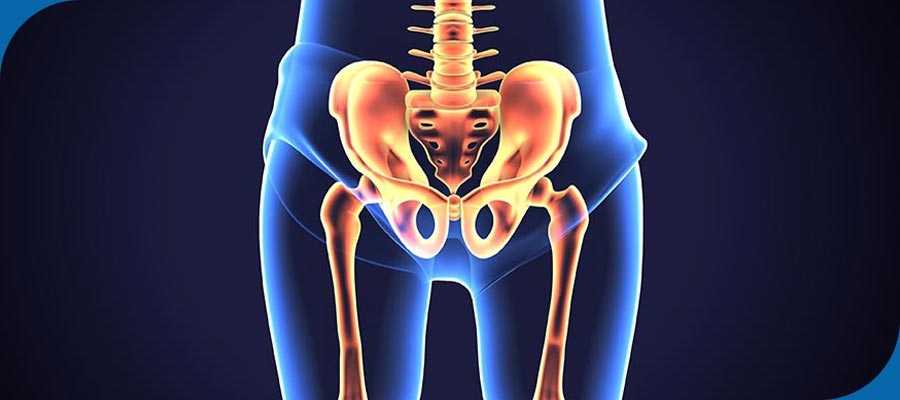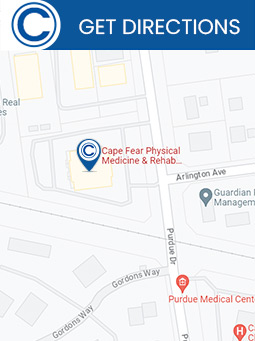Sacroiliac Joint Injections Specialist in Fayetteville NC
At Cape Fear Physical Medicine and Rehab, our professional team specializes in Sacroiliac Joint Injections to provide effective pain relief for patients suffering from pelvic pain. These injections target the sacroiliac joints to reduce inflammation and alleviate discomfort, helping you regain mobility and improve your quality of life. Our professional team works with you to develop a personalized treatment plan that addresses your unique needs, ensuring the best possible results. For more information, contact us or schedule an appointment online. We are conveniently located at 1540 Purdue Dr, Ste. 200, in Fayetteville, NC 28303.




Table of Contents:
What is the purpose of sacroiliac joint injections?
What aggravates sacroiliac joint pain?
What can I expect after a sacroiliac joint injection?
How often can you get sacroiliac joint injections?
Made up of the sacrum and the ilium, the sacroiliac joints connect the pelvis and the lower spine. There are two sacroiliac joints, one on each side of the lower back. Dysfunction in either of these joints can cause leg pain, as well as pain in the lower back. Due to the similarity of their symptoms, sacroiliac leg pain can be hard to differentiate from sciatica. Because the sacroiliac joints are responsible for 15% to 30% of cases of lower back pain, it is essential to receive a professional diagnosis when experiencing lower back or leg pain.
There are two main purposes of sacroiliac joint injections. The first is to diagnose the source of a patient’s pain, and the second is to provide therapeutic pain relief. Although the two are often combined into one injection, at times these are separated and a patient will either undergo a purely diagnostic or therapeutic injection.
• Diagnosis — A diagnostic SI joint injection, which is performed by numbing the sacroiliac joint with a local anesthetic, is used to confirm a suspected diagnosis of sacroiliac joint dysfunction. The injection is performed using X-ray guidance for improved accuracy. After the numbing medication is injected, the patient is asked to perform activities that previously caused pain or irritation. A tentative diagnosis of SI joint dysfunction is made if the patient experiences 75-80% pain relief for the normal duration of the anesthetic. Further tests using a different numbing agent may be performed to confirm the diagnosis.
• Pain Relief — A therapeutic SI joint injection is performed to relieve pain associated with sacroiliac joint dysfunction. The procedure is performed using the same technique as a diagnostic SI joint injection; the only difference is that an anti-inflammatory medication is included in the injection. Typically a corticosteroid, an anti-inflammatory medication is used to provide pain relief by reducing inflammation within the joint.
Common aggravators of sacroiliac joint pain include:
• Heavy impact activities, such as:
• Running
• Jumping
• Contact sports
• Labor intensive jobs
• Standing for prolonged periods of time
• Deconditioned and weak muscles, including:
• Abdominal muscles
• Gluteal muscles
• Spinal muscles
Each individual may experience different symptoms that can be aggravated by certain activities, so it is important for each person to pay attention to the specific activities that aggravate their pain to avoid these in the future. Pain management is key in addressing these triggers and developing strategies to minimize discomfort, allowing individuals to live more comfortably.
A sacroiliac joint injection immediately improves pain. After the procedure, pain and soreness at the injection site are normal for a day or two. The steroid medications may take a few days (typically two to three days) to show their results. Temporary numbness or weakness in the legs may be experienced due to the anesthetic. Some patients may experience a slight increase of discomfort related to the inflammatory chemicals in the injections, which help to heal the SI joint in the long run.
Depending on the severity of symptoms and findings of the physical exam, sacroiliac joint injections may be recommended by a spinal specialist.
Most patients experience pain relief after only one or two sacroiliac joint injections. The maximum frequency for SI injections is three injections within a six-month time frame, as exceeding this amount can cause adverse reactions.
At Cape Fear Physical Medicine and Rehab, our professionals are committed to helping you manage painful symptoms and injuries that can hold you back from enjoying life to its fullest potential. Contact us today for more information about sacroiliac joint injections, or simply schedule an appointment online. We are conveniently located at 1540 Purdue Dr, Ste. 200, in Fayetteville, NC 28303. We serve patients from Fayetteville NC, Woodfield NC, Hope Mills NC, Fort Bragg NC, Eastover NC, and surrounding areas.

Additional Services You May Like
▸ Weight Loss & Wellness Program
▸ Botox for Migraine
▸ EMG Nerve Conduction Studies
▸ Epidural Steroid Injections
▸ Radiofrequency Ablation
▸ Rehabilitation Consultations
▸ Facet Injections
▸ Sacroiliac Joint Injections
▸ Joint Injections
▸ Genicular Nerve Blocks
▸ Prosthetic Evaluation/Management
▸ Adjuvant Therapy/Care
▸ Spasticity Management
▸ Stroke Treatment
▸ Multiple Sclerosis
▸ Spinal Cord Injury
▸ Traumatic Brain Injury
▸ Lifestyle Medicine
▸ Phentermine
▸ Qsymia
▸ Contrave

Additional Services You May Like
▸ Weight Loss & Wellness Program
▸ Botox for Migraine
▸ EMG Nerve Conduction Studies
▸ Epidural Steroid Injections
▸ Radiofrequency Ablation
▸ Rehabilitation Consultations
▸ Facet Injections
▸ Sacroiliac Joint Injections
▸ Joint Injections
▸ Genicular Nerve Blocks
▸ Prosthetic Evaluation/Management
▸ Adjuvant Therapy/Care
▸ Spasticity Management
▸ Stroke Treatment
▸ Multiple Sclerosis
▸ Spinal Cord Injury
▸ Traumatic Brain Injury
▸ Lifestyle Medicine
▸ Phentermine
▸ Qsymia
▸ Contrave







